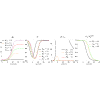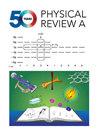Superfluid–Bose-glass transition in a system of disordered bosons with long-range hopping in one dimension
IF 2.9
2区 物理与天体物理
Q2 Physics and Astronomy
引用次数: 0
Abstract
We study the superfluid–Bose-glass transition in a one-dimensional lattice boson model with power-law decaying hopping amplitude , using bosonization and the nonperturbative functional renormalization group (FRG). When is smaller than a critical value , the U(1) symmetry is spontaneously broken, which leads to a density mode with nonlinear dispersion and dynamical exponent ; the superfluid phase is then stable for sufficiently weak disorder, contrary to the case of short-range hopping where disorder is a relevant perturbation when the Luttinger parameter is smaller than . In the presence of disorder, however, long-range hopping has no effect in the infrared limit and the FRG flow eventually becomes similar to that of a boson system with short-range hopping. This implies that the superfluid phase, when stable, exhibits a density mode with linear dispersion () and the superfluid–Bose-glass transition remains in the Berezinskii-Kosterlitz-Thouless universality class, while the Bose-glass fixed point is insensitive to long-range hopping. We compare our findings with a recent numerical study.

一维长程跳变无序玻色子系统中的超流体-玻色玻璃转变
我们利用玻色子化和非微扰函数重正化群(FRG)研究了一维晶格玻色子模型中的超流体-玻色玻璃转变,该模型具有幂律衰减的跳变振幅ti-j∼1/|i-j|α。当α小于临界值αc<3时,U(1)对称性被自发打破,从而产生具有非线性色散和动力学指数z=(α-1)/2的密度模式;超流体相在足够弱的无序状态下是稳定的,这与短程跳跃的情况相反,当鲁丁格参数小于3/2时,无序是一个相关的扰动。然而,在存在无序的情况下,长程跳变在红外极限没有影响,FRG流最终变得与具有短程跳变的玻色子系统相似。这意味着超流体相在稳定时表现出一种线性弥散的密度模式(z=1),超流体-玻色玻璃转变仍然处于别列津斯基-科斯特利兹-无普适性类别中,而玻色玻璃定点对长程跳跃不敏感。我们将我们的发现与最近的一项数值研究进行了比较。
本文章由计算机程序翻译,如有差异,请以英文原文为准。
求助全文
约1分钟内获得全文
求助全文
来源期刊

Physical Review A
物理-光学
CiteScore
5.40
自引率
24.10%
发文量
0
审稿时长
2.2 months
期刊介绍:
Physical Review A (PRA) publishes important developments in the rapidly evolving areas of atomic, molecular, and optical (AMO) physics, quantum information, and related fundamental concepts.
PRA covers atomic, molecular, and optical physics, foundations of quantum mechanics, and quantum information, including:
-Fundamental concepts
-Quantum information
-Atomic and molecular structure and dynamics; high-precision measurement
-Atomic and molecular collisions and interactions
-Atomic and molecular processes in external fields, including interactions with strong fields and short pulses
-Matter waves and collective properties of cold atoms and molecules
-Quantum optics, physics of lasers, nonlinear optics, and classical optics
 求助内容:
求助内容: 应助结果提醒方式:
应助结果提醒方式:


